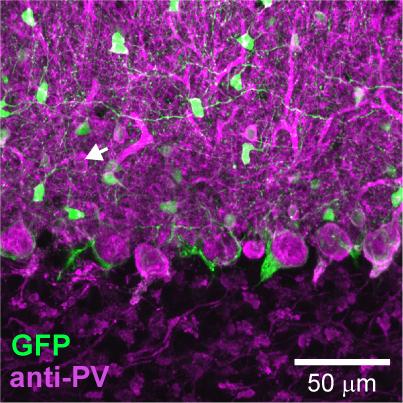MPFI scientists probe function of cerebellar interneurons with new technique

This image from c-kit IRES-Cre mice injected with AAVs using CAG promoter and co-labeled with parvalbumin (PV) antibody. Credit: Max Planck Florida Institute for Neuroscience.
The cerebellum is an area of brain at the back of your head involved in movement. Its neuronal circuitry is relatively simple compared to other areas, but scientists still have a lot left to learn regarding its role in motor control and motor learning. The cerebellum is composed of several distinct types of neurons and isolating the function of each individual type of neuron within its circuit has remained a challenge.
Purkinje neurons are the only cells that send information outside of the cerebellum, but their output is influenced by several other types of neighboring cells, including local inhibitory interneurons located in the molecular layer.
Researchers have been interested in these cells because they are known to prevent over excitation and are likely to be involved in motor disorders such as cerebellar ataxia. However, they are difficult to study in isolation.
There have been many attempts to understand the role of these inhibitory interneurons in cerebellar function. But as Matt Rowan, Ph.D., a Research Fellow who worked on the study mentioned, most methods have come up short in selectively targeting these interneurons. Samantha Amat, a lead author of the study, explained, “The solution was to find a gene uniquely expressed by interneurons of the molecular layer, but aren't expressed in neighboring cells – and this is exactly what we developed.”
Jason Christie, Ph.D., Research Group Leader at MPFI and his team working in collaboration with the lab of Hiroki Taniguchi, also at MPFI, published their study in PLOS ONE in June 2017 describing their technique for selectively targeting and controlling the interneurons of the cerebellar molecular layer relying on a genetically engineered mouse model that exploits a unique gene encoding c-Kit to differentiate interneurons from other cell types.
C-Kit is a protein robustly expressed by inhibitory interneurons of the cerebellar molecular layer, but weakly expressed by other cerebellar cell types, like mature Purkinje cells, making c-kit a good candidate gene to target molecular layer interneurons.
By using the c-kit mice in this study, the team was able to specifically access molecular layer interneurons and manipulate their activity using both optogenetic and chemogenetic methods in vitro. The technique should be able to provide similarly exciting results in vivo studies in the future.
“Our new method has transformed the research that we're doing.” said Rowan, who is already working on more projects employing these mice. By understanding the role of interneurons in cerebellar function, the team hopes to identify new ways to treat debilitating conditions that affect movement.
###
This work was supported by the National Institutes of Health Grants (NS083984 and NS083127), the Japan Science and Technology Agency (JSTPRESTO), the Max Planck Florida Institute for Neuroscience, and Max Planck Society. The content of this article is solely the responsibility of the authors and does not necessarily represent the official views of the funding agencies.
About MPFI
The Max Planck Florida Institute for Neuroscience (Jupiter, Florida, USA) specializes in the development and application of novel technologies for probing the structure, function, and development of neural circuits. It is the first research institute of the Max Planck Society in the United States.
Media Contact
All latest news from the category: Life Sciences and Chemistry
Articles and reports from the Life Sciences and chemistry area deal with applied and basic research into modern biology, chemistry and human medicine.
Valuable information can be found on a range of life sciences fields including bacteriology, biochemistry, bionics, bioinformatics, biophysics, biotechnology, genetics, geobotany, human biology, marine biology, microbiology, molecular biology, cellular biology, zoology, bioinorganic chemistry, microchemistry and environmental chemistry.
Newest articles

NASA: Mystery of life’s handedness deepens
The mystery of why life uses molecules with specific orientations has deepened with a NASA-funded discovery that RNA — a key molecule thought to have potentially held the instructions for…

What are the effects of historic lithium mining on water quality?
Study reveals low levels of common contaminants but high levels of other elements in waters associated with an abandoned lithium mine. Lithium ore and mining waste from a historic lithium…

Quantum-inspired design boosts efficiency of heat-to-electricity conversion
Rice engineers take unconventional route to improving thermophotovoltaic systems. Researchers at Rice University have found a new way to improve a key element of thermophotovoltaic (TPV) systems, which convert heat…



